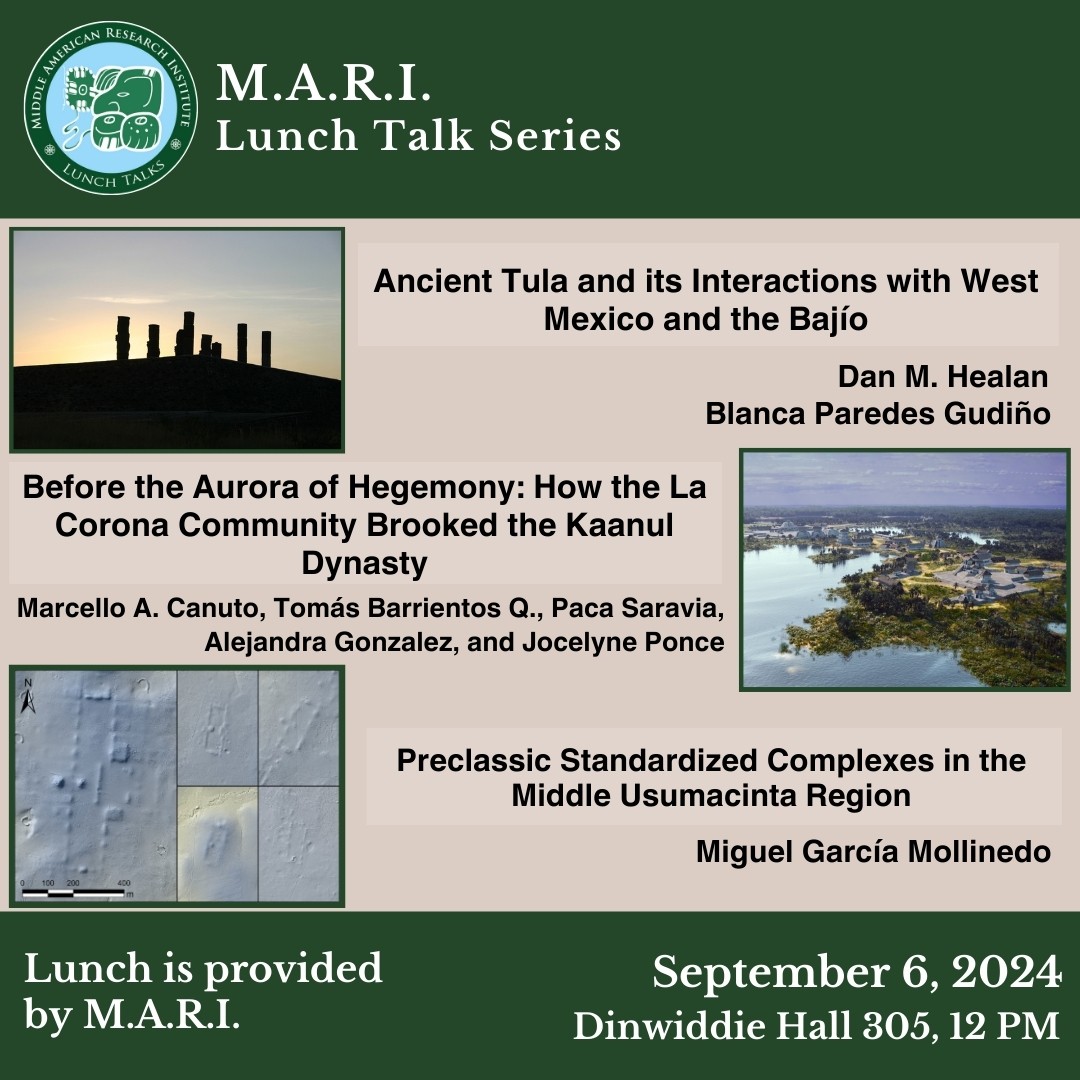
Join the Middle American Research Institute on their inaugural Lunch Talk of the Fall Semester. M.A.R.I. Lunch Talks invite guest speakers to host seminars at MARI on a wide variety of topics related to the archaeology, history, and ethnography of Mesoamerica and other world areas.
Ancient Tula and its Interactions with West Mexico and the Bajío
Dan M. Healan - Department of Anthropology, Tulane University | Blanca Paredes Gudiño - Instituto Nacional de Antropología e Historia
Archaeological investigations at Tula, Hidalgo have recovered evidence of systematic exchange with other areas of Mesoamerica spanning Tula's initial growth in the Epiclassic period and its Early Postclassic apogee. The evidence includes finds from many parts of Mesoamerica, some recovered from contexts associated with Tula's elite, while many other items, including some of the most sensational recent finds, were recovered from the everyday domestic realm. While collectively spanning a wide range of Mesoamerica, we focus upon interaction with West Mexico and the Bajío as a possible direct and indirect source of many of these items, while documenting evidence of Tula's direct and indirect presence in these two areas.
Before the Aurora of Hegemony: How the La Corona community brooked the Kaanul dynasty
Marcello A. Canuto, Tomás Barrientos Q., Francisco Saravia, Alejandra Gonzalez, and Jocelyne Ponce - Department of Anthropology, Tulane University, Universidad del Valle de Guatemala & Universidad de San Carlos de Guatemala
By examining archaeological and epigraphic evidence from the northwestern Peten during the Classic period, we can gain valuable insights into the strategies used by the Kaanul dynasts to establish and maintain a unique regional hegemony in the Maya Lowlands. We focus on the site of La Corona where we have integrated archaeological and epigraphic data to examine the significance of the early rulers in this particular geographical area. Looking to architectural construction, ceramic affiliation, epigraphy, and settlement, we investigate the changes in the nature and organization of the La Corona community in the AD fifth and sixth centuries. Based on the available data, we suggest that the northwestern Peten region held significant strategic importance, serving as a crucial location for both the initial expansion of the Kaanul dynasty in the early AD sixth century and the subsequent transformation and maintenance of its dominant control during the AD seventh and eighth centuries. We therefore aim to model in what ways the changes in the Kaanul dynasty regime impacted this community and set it on the course to become its long-standing subordinate ally.
Preclassic Standardized Complexes in the Middle Usumacinta Region
Miguel García Mollinedo - Department of Anthropology, Tulane University
In the Middle Usumacinta region, located in southeastern Mexico, multiple standardized architectural complexes dated from the Middle Preclassic period (1000 - 400 B.C.) have been detected with the use of LiDAR technology. Of these complexes, 3 belong to the Middle Formative Chiapas (MFC) pattern, at least 89 have been classified into the Middle Formative Usumacinta (MFU) pattern, and 59 more could be associated with this pattern. The degree of architectural standardization, the differences in proportions, and the spatial distribution of the complexes suggest that during the Middle Preclassic, a phenomenon of political and ideological integration was gestated in the region. Regional settlement pattern data was analyzed using analytical tools in Geographic Information Systems (GIS), and digital elevation models (DEM) created from LiDAR data. This study consisted of the analysis of the distribution of the standardized complexes, their proximity to water bodies, and their correlation with geomorphological units. Subsequently, different GIS analyses were used to classify the complexes into archaeological sites. This classification served to propose a rank-size site hierarchy based on the area of the plazas and the volumes of the structures. Finally, this rank-size proposal was used to perform territoriality and mobility spatial analyses.
